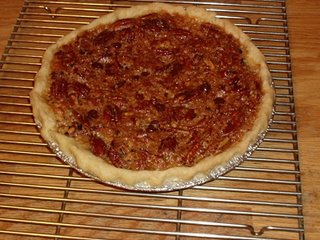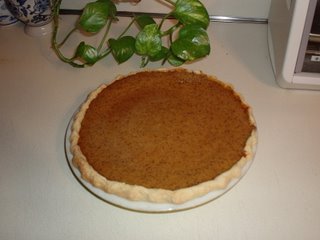Back to the drawing board or, rather, my recipe basket. I have a large basket where I throw copies of interesting recipes I come across in print publications. I knew that somewhere in that basket was a recipe for a pear pie that did not involve most of the unhealthy ingredients found in pumpkin and sweet potato pie recipes. It took a little digging, but I found it. It was part of a menu from the April 1, 2006 issue of Family Circle Magazine.
The recipe calls for a prepared piecrust. I opted for a homemade one using a recipe from Martha Stewart. I called on A’s expertise (she works in the nutrition field) to determine which was healthier, shortening or butter. She recommended I go with butter because it has far less trans-fats than shortening. With this in mind, I used Martha’s Basic Pie Crust which makes enough for a single crust pie.
I liked this recipe because it uses a food processor to blend the ingredients. I was surprised at how effortlessly the pastry came together. I’m seriously considering using my food processor for all of my pie crusts despite the fact that it is a pain to clean. This was also the easiest pastry I have ever rolled. In the future, I think I will use a shortening crust with this recipe because when it came time to fold the pastry over the pear filling, the pastry was quite limp. Instead of forming a nice pocket as you would expect from a stiffer shortening crust, Martha’s butter crust was more like wrapping the filling in a scarf.
I discovered that my A&P carries three varieties of pears, Anjou, Bartlett and Bosc. I don’t know if there are any taste differences but in terms of size, three Bartlett pears weigh almost exactly 1 ½ pounds as called for in the recipe. The recipe doesn’t specify that you should peel the pears but I couldn’t imagine that leaving the skins on would enhance the flavor or texture, so I peeled them. Unlike the Mushroom-Wild Rice stuffing, the 1/8 teaspoon of nutmeg enhanced, rather than overpowered, the pears and brown sugar. I left out the butter and could also have skipped the milk and sugar on the crust.
The end result was delicious. The recipe recommends the pie be served warm but I also liked it straight out of the refrigerator the next day. I’ve now added another fruit pie to my small repertoire.
Verdict: Yum!! This one’s a keeper!!
1 ¼ cups all-purpose flour (spooned and leveled), plus more for rolling
½ teaspoon salt
½ teaspoon sugar
½ cup (1 stick) cold unsalted butter, cut into pieces
2 to 4 tablespoons ice water
In a food processor, briefly pulse flour, salt, and sugar. Add butter; pulse until mixture resembles coarse meal, with a few pea-size pieces of butter remaining. Sprinkle with 2 tablespoons ice water. Pulse until dough is crumbly but holds together when squeezed (if necessary, add up to 2 tablespoons water, 1 tablespoon at a time). Don’t overmix.
Turn dough out onto a large piece of plastic wrap. Fold plastic over dough; press to shape into a 1-inch-thick disk. Refrigerate until firm, at least 1 hour (or up to 3 days).
On a floured piece of parchment paper, roll dough to a 14-inch round with a floured rolling pin. Wrap dough around rolling pin, discarding paper; unroll over a 9-inch pie plate. Gently fit into bottom and up sides of plate (do not stretch dough).
Using kitchen shears, trim dough to a 1-inch overhang. Fold under itself to form a rim, and press to seal. Using thumb and forefinger, crimp rim of crust. Refrigerate until ready to use, up to 1 day.
One 9-inch crust.
3 ripe but firm Bartlett pears (about 1 ½ pounds total)
¼ cup light-brown sugar
⅛ teaspoon ground nutmeg
1 refrigerated prepared piecrust (from a 15-ounce box)
1 tablespoon unsalted butter, cut up
1 tablespoon heavy cream or milk
Heat oven to 400°.
Cut pears in half; remove cores. Cut in thin slices. In large bowl, toss with 3 tablespoons of the sugar and the nutmeg.
Place piecrust on work surface; gently roll out to 14 inches in diameter and place on ungreased baking sheet. Mound pear slices in center, leaving a 2-inch border. Dot butter over pears. Fold edge of crust up and partway over filling. Repair any tears by pressing pastry together. Brush pastry edge with cream. Sprinkle with the remaining sugar.
Bake on the bottom shelf at 400° for 35 minutes until filling is hot and crust is golden; place foil loosely over pie if crust browns too quickly. Let cool on pan or rack 10 minutes before serving. Can be baked ahead and reheated at 400° until warmed through. Serve with ice cream, if desired.
Compost: pear cores and skins













